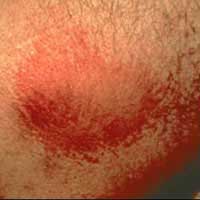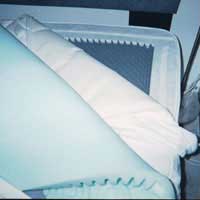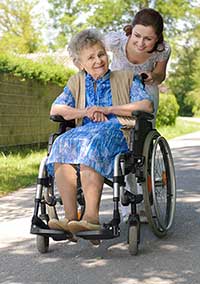
- Pressure ulcers (or bed sores) most often occur over bony areas such as the tailbone, hip, ankles, back of the head, heels, elbows or shoulder blades.
- More than 25% of older people in healthcare institutions and 15% of those living in the community develop pressure ulcers.
- Pressure ulcers are most likely to happen to older people who are not mobile, who are ill, and/or who have physical or mental conditions.
- Prevention includes maintaining activity, changing position, avoiding friction and shear, and maintaining proper skin moisture. Special devices and equipment are also available.
Areas of skin redness and open sores should be reported to a health care provider.
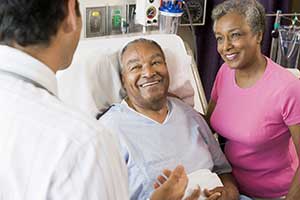
- A pressure ulcer (also known as a bed sore or pressure sore) is a change or break in the skin caused by constant pressure, friction or shear (skin rubbing or pulling against the bed or chair or other surface while the person is being turned or moved).
- Pressure ulcers decrease quality of life, may be painful, and require dressing changes.
- Pressure ulcers are a big concern in healthcare. Up to 60% of pressure ulcers can be prevented, by learning how they are caused, and what can be done to prevent them.
- After a pressure ulcer has healed, the skin in that area is not as strong as before, and can break down more easily.
APPEARANCE
- A pressure ulcer can appear as a red or discoloured area on the skin, as a blister, or as an open sore. It can develop quickly, especially over bony areas like the buttocks and heels.
- Pressure ulcers can also develop in often-overlooked areas, such as the back of the head, behind the ears (where oxygen tubing rubs), or on the ears (from lying in bed).
FACTORS CONTRIBUTING TO PRESSURE ULCERS
People who can't move themselves or who have decreased mobility are at high risk for developing pressure ulcers.
- Staying in one spot for longer than two hours without changing position causes reduced blood flow to that area and the tissue becomes starved of nutrients, blood, and oxygen.
- A low level of pressure sustained over a long period can be just as damaging to tissue as a high level of pressure for a shorter period.
Watch for pressure ulcers if your family member is experiencing pain.
- If the pain is not controlled, they may not feel like moving around or changing position.
- If they have too much pain medication, they may not have the capacity to move.
Your family member may not be able to feel or sense the discomfort that happens when pressure ulcers begin.
- If they cannot respond to the touch of a hand or to stronger stimuli, they are at much higher risk for developing pressure ulcers.
- If they are confused, they may not be aware of discomfort from being in one position for prolonged periods.
If your family member has an increase in body temperature or moisture, they are at higher risk of developing a pressure ulcer.
AVOIDING PRESSURE ULCERS
Staying active is important. Go for walks regularly, if possible, or change position frequently. If your family member can only sit in a chair, remind them to make small shifts in position from hour to hour. A family member who is bedridden may be unable to change position and take pressure off the bony areas. They need help to move and redistribute the pressure.
- Place pillows behind their back when turning from side to side.
- Pillows are also effective when placed under the heels to reduce the pressure in those areas.
- Don't overlook the pressure that occurs when the knees are close together. Place a folded blanket or sheet to separate the knees.
Sitting upright in bed or in a chair puts extra pressure on the tailbone. Rule of thumb: Never raise the head of the bed past 30 degrees (unless there are swallowing problems).
SPECIALIZED EQUIPMENT
- Specialized beds and mattresses are available to help reduce pressure ulcers and increase comfort. They work by distributing pressure over a wider area.
- Special cushions are available that you can put on a chair to redistribute the pressure on the backside. An Occupational Therapist can help you obtain these devices.
- Do NOT use doughnut devices as these localize pressure to other areas.
NUTRITION AND PRESSURE ULCERS
Nutrition plays an important part in preventing pressure ulcers.
- It is important that your family member eat enough protein, vitamins, and minerals and drink enough water.
- Eating well is important to rebuild cells when they break down.
- Protein supplements may help improve nutrition, speak to a dietitian or your healthcare provider about nutritional supplements for your family member.
INCONTINENCE AND PRESSURE ULCERS
If your family member is incontinent, the moisture from urine and waste products can cause the surface of the skin to become red or irritated. It is very important to:
- remove the waste as soon as possible
- clean the skin gently with water and mild soap (non-perfumed), and dry the area well with a soft towel.
Control pads and barrier creams can help keep the moisture away from the skin. Barrier creams should be applied in a thin layer, and should be removed (using soap and water) and re-applied following an incontinence episode.
SKIN MOISTURE AND PRESSURE ULCERS
- Moisture on the skin makes the skin more fragile, and more easily damaged by pressure, friction or shear. This is also true if the skin is too dry, as it causes skin to break down.
- Skin moisturizers can be helpful for dry skin, and barrier creams for moist or wet skin.
FRICTION, SHEAR AND PRESSURE ULCERS
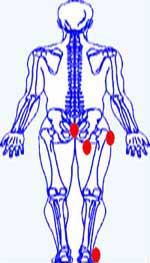 Friction and shear from movement can contribute to skin
breakdown and pressure ulcers.
Friction and shear from movement can contribute to skin
breakdown and pressure ulcers.
- Dragging the heels on the bed or sliding the buttocks against the bed or chair can damage the top layer of skin.
- Shear happens when the deeper tissues are pulled and torn from these changes in position.
When moving up in bed, the feet should be placed flat on the surface of the bed and used to help push.
When sitting upright in bed, all of the pressure is on the buttocks. Sliding down can result in friction and shear that harms the skin.
Do not rub or massage red areas on the skin, as this causes shearing of the tissues below the skin surface.
TIPS FOR AVOIDING PRESSURE SORES
- Check skin daily. Watch for skin changes such as redness that will not go away, as this may be a pressure ulcer.
- Home visits from a health care professional should include a head-to-toe skin assessment to identify problems early.
- Stay active. Activity stimulates the blood flow and reduces the risk of pressure sores.
- Keep skin moisture in balance. Not too wet, not too dry. Use barrier creams and moisturizers as necessary.
- Change position at least every two hours. Use a clock as a reminder, or change positions on even or odd hours.
- Eat well and drink plenty of fluids unless otherwise told. If necessary, talk to a Dietitian.
- If there is an area of skin redness or an open area, seek help from a health care professional.
National Pressure Ulcer Advisory Panel
- According to the website, it "serves as the authoritative voice for improved patient outcomes in pressure ulcer prevention and treatment through public policy, education and research."
- American Academy of Family Physicians website offers comprehensive information about pressure sores.
